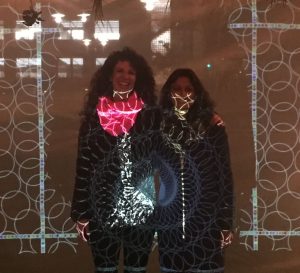On Tuesday October 12, 2017, Design students in Professor Liat Berdugo and Professor Noopur Agarwal’s Digital Literacy classes displayed their work on the Digital Canvas as a part of “Open Doors.” Hosted by the The Swig Program in Jewish Studies and Social Justice and The Kitchen, “Open Doors” celebrated the Jewish holiday of Sukkot, which takes place over a week. It is named after the temporary structures created for the celebration, the sukkah. A reminder of the transient nature of life and the welcoming nature of the sukkah, campus groups came together with a program of events over eight nights to build on ideas of openness. The Digital Canvas allowed students to share their works of “fast” media against the traditional structure. Professors Berdugo and Agarwal tell us why they decided to participate in the event, and how it came together.
How does the Digital Canvas relate to the idea of Open Doors? Why did you decide to blend the two together?
Liat Berdugo: There are many interpretations of the theme of “Open Doors” and “Digital Canvas” but for me, this idea starts with very nature of what a “sukkah” is.
A “sukkah” is the name given to a temporary structure described in the Torah (also known as the Old Testament). Its construction is a Jewish ritual — but offers broader themes along the trend lines of contradictions. A “sukkah” is a building that is an embodiment of contradictions — simultaneously open and closed, new and old, timely and timeless, mobile and stable, familiar and unusual. The idea of the “Digital Canvas” is to highlight the contradiction of new and old (since the Sukkah is an old idea, but digitality and the digital projections are relatively new concepts), and to highlight the contraditions of stable (via an architectual structure) and mobile (via digital projections. The entire event of the “Digital Canvas” juxtaposes digital and ‘fast’ media onto the physical itinerant structure of the sukkah.
The event as a whole relates to the theme of “Open Doors” as it builds a temporary space in which community members from USF will convene for conversations about and experiences of itinerant art.
Noopur Agarwal: Digital projections can be used to transform a space for the viewer. Throughout the 8 days of the “Open Doors” festival the “sukkah” and the space it occupies is being utilized for different programing / gatherings / discussions, so it seems fitting to take a moment to transform the space into an art instillation for discussion/introspection as well.
Why did you feel it was important for students to show their work on the Digital canvas?
LB: I feel that it is always important for students to have opportunities to show their work — and especially to do so inside their own communities. When artists and designers show their work inside their own communities, they see its impact; they feel investment; they hear feedback; and they can begin to see the value of artistic and design practices in talking about themes that apply to society at large. Taken together, these form the meat of an important art or design practice.
NA: It is also important for students to see their work in different contexts—large, small, indoors, outdoors, on a computer screen, projected, printed, etc. to see how their piece can change for the better, the worse, or in unexpected ways.
How was it partnering with other groups of the USF community, like the USF Community Garden, Performing Arts and Social Justice, Urban Agriculture, University Ministry, and San Francisco Muslim Community Center and St. Ignatius Church, to create an immersive experience with the larger USF community?
LB: The main partners with whom I worked on this project were The Kitchen, who owned the Sukkah structure, the department of Theology and Religious Studies, and the Swig Program in Jewish Studies and Social Justice. It was wonderful and inspiring to learn more about each of these organizations and departments — how they work, what fuels them, who they serve, and why. I always find it wonderful when projects draw together a crossroads of campus activity and community partners!
NA: Liat did most of the initial coordination, but it has been a really warming experience to see all of the additional faculty, staff, and students that have gotten involved / supported the initiative who were not initially part of the planning committee. It truly is a community effort!




